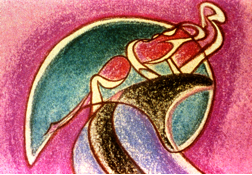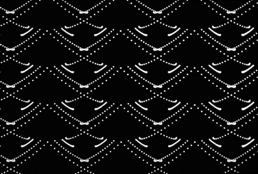Abstract animation is not included in many animations festivals or venues. [1] Yet, abstraction is not the exception in other arts, notably sculpture, painting, and most importantly, music. The language of abstraction is inherent in human nature and allows us to escape the confines of spoken word and explore other means of expression and sharing of experience; to transcend. Filmmaker Jordan Belson explained that his films were not just audio-visual compositions but attempts to document internal experience. “My whole aesthetic rests on discovering what’s there and trying to discover what it all means in terms of relating to my own experience in the world of objective reality.”(Youngblood)
“Abstract”, in this context, includes non-objective as well. [2] Artists may abstract from the real as in Sara Petty’s Furies, which foregrounds two lively cats. The visual form is abstract, with lines and forms expressing the energetic rough-housing. We are transported into another world.
Larry Cuba’s Two Space, on the other hand, has no object reference but rather expresses Cuba’s contemplation of form, rhythm and pattern using programmed points in space.
Expectations connected with viewing narrative work should be suspended, especially the need to decipher what is happening. And while the work may be enjoyable, these are not works made purely to entertain. No story arc is present. There is structure, more akin to that of music than literature. Often the mind wanders as the viewer enters a different type of experience, perhaps more like that of watching clouds. Thoughts emerge and disappear. Clouds were the inspiration for Len Lye who recalled being enthralled with their fast, scurrying motion after a rain storm. “All of a sudden it hit me – if there was such a thing as composing music, there could be such a thing as composing motion. After all, there are melodic figures, why can’t there be figures of motion?”(Lye)
Abstract created moving imagery – animation – has a history with music performance. Long before film, Father Louis Bertrand Castel, around 1730, invented and performed on one of the earliest instruments, the Ocular Harpsicord, which emitted color light imagery at the same time as music. Harry Smith’s early animations were sometimes projected to live jazz music and light shows performers such as Single Wing Turquoise Bird and the Joshua Show accompanied rock concerts.
It is not uncommon to encounter abstract animation at a music concert or new media art venue, rather than the theater. Emerging – and merging – technologies enable the creation of sound and complex, abstract moving images. Artists code and connect via midi and software programs such as Max MSP, Processing, and Isadora to perform in real-time or to compose. As with Father Castel’s vision in the 18th century, audio informs and creates images, images and/or movement create sound.
Whatever the venue, abstract animation, like music and other abstract arts, is integral to the expression of our nonverbal experiences and imaginings.
Works cited:
- Len Lye, Figures of Motion (Auckland, New Zealand: Auckland University Press, 1984) 31-32
- Gene Youngblood, Expanded Cinema, (New York: E.P. Dutton & Co., Inc., 1970) 159
Notes:
[1] The Punto y Rayo Festival is the exception as it is dedicated to abstraction in motion. http://www.puntoyrayafestival.com/en/index.php. The EYEWORKS Festival of Experimental Animation focuses on experimental work, including abstract and non-objective.
[2] The author presented a more in-depth treatise on abstract animation, “Content and Meaning in Abstract Animation” at Siggraph 2003. Available online, http://www.people.vcu.edu/~ptturner/website/sources/Turner%20Course%20Notes-Color1.pdf
Pamela Turner is Chair of the Department of Kinetic Imaging, and Associate Professor, at Virginia Commonwealth University where she teaches animation studio and history. She is the official biographer of the late Adam Beckett, a pioneering animator in the mid-1970s.



Amazing abstract animation on https://vimeo.com/176714277
At Animate we also try and do our bit..commissioning contemporary work that, whilst certainly ‘abstract’, also extends and challenges more orthodox/traditional understanding of what ‘abstract animation’ is:
http://www.animateprojects.org/films/by_date/20141/navigations
http://www.animateprojects.org/films/by_date/20141/little_boy
http://www.animateprojects.org/films/by_date/2012/shift
Not being restricted to a storyline and characters, abstract animation could be a more liberating art form for the artist and the audience.
I’d certainly like to see more abstract work. It can be really inspiring, even if what it inspires is more figurative.
It is a shame that abstract animation is not more widely seen, as it is often quite a beautiful and thought provoking medium for art. The Eyeworks festival in the States does an excellent job in partially rectifying this – http://eyeworksfestival.com